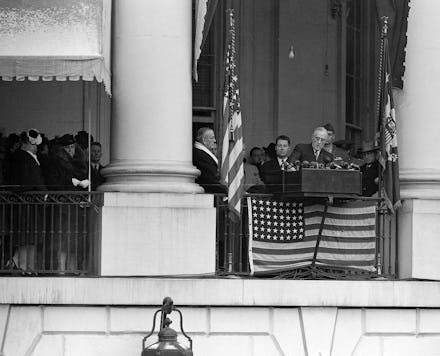Why We Have Inaugurations: The history behind the presidential swearing-in ceremony

On Jan. 20, Donald Trump will take the Oath of Office and be sworn in as the 45th president of the United States.
The theme of the ceremony, the 58th in the nation's history, will be Trump's campaign slogan: Make America Great Again.
Keeping with a tradition set in 1837 when Andrew Jackson handed the office over to Martin Van Buren, President Barack Obama will travel with Trump to the Capitol building to watch as he's sworn in. After Trump and Mike Pence are sworn in as president and vice president, respectively, they will walk down Pennsylvania Avenue in the Inaugural Parade.
The tradition of the ceremony symbolizes the peaceful transfer of power from one administration to the next, which President Obama in a 2016 executive order hailed as a "hallmark of American democracy."
The First Inauguration
The tradition of the inauguration ceremony began with the nation's first president, George Washington.
It was April 1789 and Washington had traveled from his home in Virginia to Federal Hall in New York City, where Congress had just chosen him as the nation's first president. On a balcony overlooking Wall Street, above a crowd of spectators, Washington took the first Oath of Office: "I do solemnly swear that I will faithfully execute the office of President of the United States, and will, to the best of my ability, preserve, protect and defend the Constitution of the United States." The language of the oath, which is written in the Constitution, has not changed to this day.
"I walk on untrodden ground," Washington wrote soon after. "There is scarcely any part of my conduct which may not hereafter be drawn into precedent."
How the tradition has changed since then
Elements of the tradition have changed over the years.
Starting with John Adams, the Oath of Office has been administered by the Chief Justice of the Supreme Court.
Thomas Jefferson was the first to have the inauguration in Washington, D.C., in 1801 — and the procession to the White House after his second inauguration formed the precedent for the Inaugural Parade we have today.
The tradition of swearing in the new president on Jan. 20 is also a relatively modern one, established with the passage of the 20th Amendment to the Constitution in 1933. Until then, the president was inaugurated in March. But the delay between the election and the swearing in made for a too-long lame duck session, and the transfer of power was moved to noon on Jan. 20 for Franklin Delano Roosevelt's second term. Obama's second inauguration took place on Jan. 21 because Jan. 20 fell on a Sunday in 2012.
Other traditions, such as the performing of "Hail to the Chief" and the location of the ceremony, have changed over the years.
But the oath itself remains the most important portion of the ceremony, according to Donald R. Kennon, the former Chief Historian of the United States Capitol Historical Society.
"People can change, policy agendas can change, parties can change, but the structure remains the same," Kennon said at a Foreign Press Center briefing in 2005. "The individuals are interchangeable, but the structure remains the same. And that's what's important."